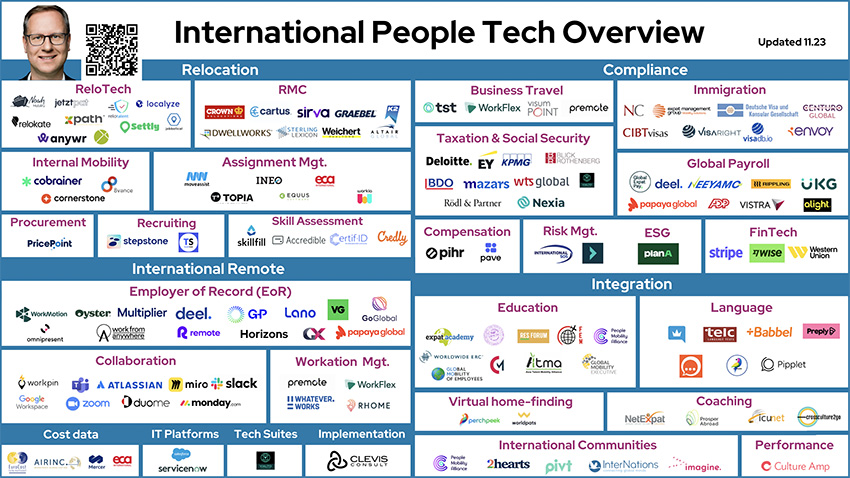The 21st-century workplace has significantly evolved beyond the digital revolution. The shift from traditional HR technologies to “People Tech” is changing both work environments and global workforce mobility. This article examines the transition from HR tech, once centred on administrative efficiency, to people tech. This new paradigm prioritises fluid workforce mobility over traditional global mobility concepts. We explore how people tech is transforming workplace dynamics, including the modalities of work and employee engagement, in a globally connected context.
The Journey from HR Tech to Work Tech
In the past, the primary focus was on HR tech. It laid the foundation for the digitization of individual or modular HR processes. Ideally, these processes were integrated through interfaces to ensure seamless functioning. But as Josh Bersin pointed out in 2021, there’s been a considerable shift from HR tech to what’s now termed as work tech.
Work tech is all about the digital tools that help people work together better, no matter where they are. It’s really useful for teams that have some people working from home and others in the office. This tech also helps people from different parts of the world work together more easily.
Think of work tech as a helping hand for teams that aren’t all in the same place. It’s great for remote work, which means you can do your job from anywhere, not just the office. It also helps teams that are spread out, or ‘distributed teams,’ to talk and share ideas just like they would face-to-face. And for teams that don’t have a central office at all, which we call ‘decentralised teams,’ work tech is super important.
So, when we talk about ‘hybrid’ in work tech, it’s not just mixing home and office work. It’s also about connecting people across different places and cultures, making it easier for everyone to work together.
Introducing People Tech: Where Technology Meets Human Needs
But what’s the next phase in this technological evolution? Enter People Tech. While HR tech and work tech predominantly focus on processes and collaboration respectively, people tech marries the concept of digitalization with the human touch.
People tech is revolutionary in the sense that it bridges the gap between purely digital processes and human interaction. Consider the scenario of an international employee relocation. With People Tech, while all relocation processes might be administered on a SaaS platform, the integration of independent consultants ensures that the relocated person still receives the human interaction and guidance they need. It’s the best of both worlds: you get the speed and ease of digital, but you still keep that personal touch. And the optimal part? Individuals can opt to use this HR tech on their own, in private, whenever they want. This opens up new possibilities for how the service is offered and used—companies can now think about selling not just to other businesses (B2B) but directly to consumers (B2C) and through businesses to consumers (B2B2C), too.
Additionally, a significant application of People Tech is in facilitating workations, a trend that blends work with travel. These platforms simplify the complexities of short-term international stays, handling everything from travel logistics to local legal compliance. Beyond logistics, they offer cultural integration tools, making transitions smoother for employees. This not only enhances workation experiences but also supports better work-life balance and productivity. As remote work becomes more prevalent, People Tech is essential in redefining where and how we work, offering flexible solutions for the modern workforce.
Harnessing Technology for Global People Mobility: Blockchain and AI
In today’s world where teams are spread across the globe, new technologies are crucial for smooth operations. Blockchain is emerging as a key technology, especially in verifying the performance records of blue-collar and frontline workers. Its ability to maintain unaltered records of skills is unmatched.
On a parallel note, Artificial Intelligence (AI) has been making waves, particularly in the recruitment sector. The role of AI in screening vast amounts of data from the global talent pool is invaluable. It can analyse and process large datasets quickly, thus streamlining recruitment processes and making talent acquisition more efficient. AI can be applied in various stages of recruitment, such as background checking or candidate screening. You can read more about the benefits of using AI in recruitment here.
People Tech in Global Mobility: A Shift to Candidate and Employee Satisfaction
Historically, the sphere of global mobility was dominated by logistical and administrative challenges. The focus was primarily on ensuring the seamless transition of employees from one location to another. However, with the advent of People Tech, there’s been a remarkable shift in focus. Today, global mobility isn’t just about moving people – it’s about ensuring that these transitions are as enriching and satisfying for the employee as possible. This has a significant impact on employees’ mental health and hence their productivity.
People Tech recognizes that international transfers are significant life events, not just logistical tasks. This perspective goes beyond digitising processes and considers the emotional and practical aspects of such transitions. From recruitment to the entire employee experience, People Tech focuses on making relocations comfortable and supportive, enhancing each stage of the employee’s career journey.
There’s a growing recognition that employee satisfaction plays a crucial role in the success of global assignments. A happy, well-adjusted employee is likely to be more productive, more engaged, and more committed to the success of their overseas assignment. Conversely, an employee struggling with relocation challenges may face productivity issues, and in some cases, may even choose to cut short their assignment, leading to additional costs and operational challenges for the organisation.
Leading technology providers in the People Tech domain are thus introducing innovative solutions focused on the mental health of relocating employees. Whether it’s a platform that connects relocating employees with local communities and support groups, an AI-driven solution that provides personalised recommendations based on an employee’s preferences, or even simple tools that make the administrative aspects of relocation more transparent and less daunting – the overarching goal is clear: to prioritise employee satisfaction.

In conclusion, as the landscape of global mobility evolves, organisations are realising the irreplaceable value of the human touch in a digital world. The seamless integration of efficient digital processes with a genuine focus on human well-being is setting the gold standard in global mobility practices. In this transformative journey, People Tech is fostering unparalleled global collaboration. By combining advanced People Tech with a global mindset, businesses are able to break down geographical barriers, enabling diverse teams to work together more effectively and innovatively than ever before. This synergy is crucial in creating a more interconnected and collaborative international business environment.
But what can be expected next in the global people tech space? Join the People Mobility Alliance to stay updated with the latest developments in People Mobility and to be at the forefront of this exciting era of global collaboration and technological advancement.
Author: Daniel Zinner
International HR expert, entrepreneur and communications consultant. His expertise lies in HR, strategy, digitalisation and transformation strategy.





